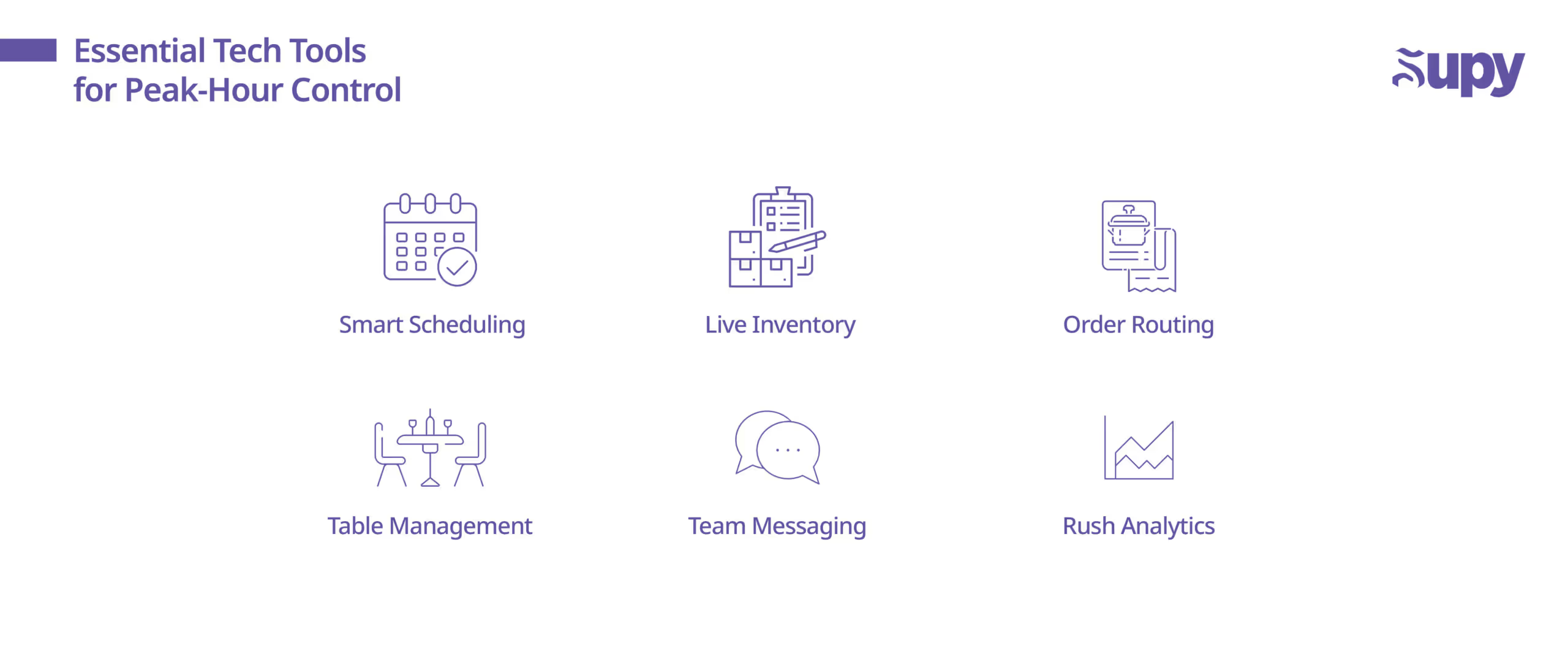Handling the Rush: Top Strategies for Managing Restaurant Peak Times

When the dinner crowd rolls in or your weekend tables fill up fast, it can put serious pressure on your team. But in the restaurant industry, these golden hours aren't something to dread, they’re prime opportunities to boost revenue, strengthen guest loyalty, and deliver an enjoyable dining experience that sets you apart.Managing restaurant peak times well starts with preparation. With smart scheduling, streamlined systems, and the right tech behind the scenes, you can keep operations running smoothly, staff confident, and customers happy, even when demand is at its highest.In this guide, we’ll break down proven strategies to help you navigate the rush with ease and make every peak period count.
- Use Data to Schedule Smarter and Build a More Flexible Team
- Streamline Kitchen Workflow to Stay Fast and Focused During the Rush
- Take Control of Inventory Before the Rush Catches You Off Guard
- Speed Up Service with Smarter Order Processing
- Turn the Rush into a Better Guest Experience
- Utilizing Technologies That Keep You in Control During the Rush
- Conclusion
- About Supy
1. Use Data to Schedule Smarter and Build a More Flexible Team
Staffing too lightly during peak restaurant hours slows service. Overstaffing during off-peak hours, on the other hand, eats into your margins. To strike the right balance, modern restaurants are turning to data-backed scheduling systems that bring precision and flexibility to daily restaurant operations.Here’s how to make it work:
- Forecast demand with real numbers: Look at your past sales and traffic patterns to predict peak restaurant hours and staff accordingly. Data-driven scheduling software helps you match headcount with real-time demand.
- Rotate shifts with intention: Balance peak and off-peak hours across your team to prevent fatigue. Use forecasting tools to identify patterns and keep backup staff ready for last-minute surges.
- Train for versatility: Cross train staff so they can cover multiple roles when things get busy. A line cook who can step into prep or a server who knows basic bar service gives you coverage where and when it matters most.
- Adopt smart scheduling tools: Use integrated systems that connect to your POS or payroll, making it easier to create, adjust, and review schedules in minutes, not hours.
- Keep communication open: Effective communication tools, like a centralized team chat, make it easy to update staff on shift changes, call-ins, or rushes. Everyone stays informed without the back-and-forth.
2. Streamline Kitchen Workflow to Stay Fast and Focused During the Rush
During peak periods, the pace in your kitchen can make or break overall service quality. If prep work is lacking or roles aren’t clearly defined, high-pressure situations can spiral into delays and errors. But with smart prep habits and better systems in place, you can turn chaos into operational efficiency.Here’s how to keep your kitchen running like clockwork:
- Prep smart before the rush: Strong time management starts before service. Pre-chop, portion, and stock every station based on forecasted demand so your staff members aren’t scrambling mid-shift.
- Define clear roles and stations: Assign each team member to a specific station, grill, salad, fryer, and use visual checklists to keep things organized. This helps eliminate confusion during high-volume rushes.
- Implement a Kitchen Display System (KDS): Replace handwritten tickets with digital screens showing live orders and updates. It improves accuracy and speeds up communication, especially under pressure.
- Support across stations: Cross-train kitchen staff to assist wherever needed. When one line cook gets slammed, others can jump in, helping maintain flow and service quality during peak periods.
- Organize the expo pass: Keep the expediting area clean and structured. Separate dine-in and delivery orders visually so runners don’t disrupt the cooks, and orders go out faster.
3. Take Control of Inventory Before the Rush Catches You Off Guard

Few things hurt customer experience more than telling someone their favorite dish isn’t available, especially during dinner service. Running out of ingredients mid-shift doesn’t just frustrate guests, it slows down your team and disrupts the flow. To keep things smooth during high demand periods, proactive inventory management is key.Here’s how to streamline inventory before the rush hits:
- Track stock in real time: Use an inventory management system that connects with your POS so every sale instantly updates your stock count. This helps you make fast decisions and avoid shortages, even during spikes in customer traffic.
- Set up smart alerts: Automated low-stock warnings let you reorder ahead of time, no more scrambling mid-shift. This keeps your prep team focused and ensures efficient operations when things get busy.
- Forecast smarter with data: Analyze past rush trends and upcoming events. Smarter forecasting lets you prep with precision, cutting food waste and ensuring you’re always stocked for your regular customers.
- Prep in bulk when needed: For especially busy shifts, batch-prep sauces, portion proteins, or stage ingredients ahead of time. It reduces bottlenecks and helps your kitchen stay ahead of the curve.
- Spot-chek waste and shrinkage: Regularly compare inventory usage to recipe management standards. Monitoring for over-portioning or spoilage ensures tighter control, and fewer surprises when things get hectic.
4. Speed Up Service with Smarter Order Processing
When your dining room is packed, slowdowns in order processing can ripple through the entire shift. If tickets take too long, modifiers are unclear, or plates sit too long in the window, both your team and your guests feel the stress. To keep up with the restaurant's capacity and maintain smooth flow, it’s critical to streamline how orders are taken and sent.Here’s how to make it happen:
- Connect front-of-house and kitchen: Use a cloud-based POS that sends orders directly to kitchen display systems (KDS) or printers. No handwritten slips, no confusion, just real-time communication that boosts service speed when every second counts.
- Enable mobile/tablet ordering: Let servers take orders on handheld devices or tablets. You can also incorporate self service kiosks or QR code menus, allowing guests to add drinks or sides themselves, reducing staff strain when the customers wait begins to grow.
- Keep the menu rush-friendly: Offer a limited menu during peak times to reduce complexity. Streamlining modifiers and simplifying prep helps the kitchen move faster and avoid order delays.
- Use an expediter to manage the line: Designate someone to organize and pace the flow of orders, group similar items, and ensure nothing sits too long. This helps eliminate confusion and keeps dishes landing at tables fresh and fast.
- Support the flow with a robust reservation system: A smart reservation or waitlist tool sets expectations before guests arrive. When your system staggers seatings efficiently, it lightens the ordering load and keeps the kitchen from being overwhelmed all at once.
5. Turn the Rush into a Better Guest Experience
Busy periods don’t have to feel chaotic, in fact, they can be your best opportunity to boost customer satisfaction and leave a lasting impression. With a few smart systems and well-trained staff, you can manage the rush in a way that keeps more customers moving through your space without compromising the experience. Small touches and streamlined processes help guests feel valued, not rushed.https://www.youtube.com/watch?v=I61_YgwFXd0Here’s how to keep customers happy even when you’re running at full speed:
- Set clear expectations: Use reservation and waitlist apps to manage table turnover and send text alerts when tables are ready. Visible seating arrangements or estimated wait times on screens near the host stand help reduce frustration before guests are even seated.
- Speed up decisions with tech: QR code or tablet menus help guests browse and order faster. Allowing mobile pay or splitting the bill on your POS system keeps things moving at the end of the meal, which is critical for prompt service.
- Balance speed with warmth: During busy periods, coach your team to greet quickly, pre-bus tables, and anticipate guest needs like condiments or extra napkins. These small actions make a big difference in how guests feel, even when the pace is fast.
- Upsell during wait times: Suggest specials, drinks, or desserts via tech or host-led prompts. Offering complimentary snacks or a preview menu while guests wait helps elevate the experience and can boost average check sizes.
- Streamline checkout: Use handheld payment devices or contactless options so guests can pay at the table quickly and easily, improving table management and helping you turn over more seats with less friction.
- Follow up with loyalty opportunities: Invite guests to join your loyalty programs during or after service. A simple digital signup while paying shows you’re interested in building a relationship, and leads to repeat visits and customer feedback that can shape future improvements.
6. Utilizing Technologies That Keep You in Control During the Rush

When every second counts, the tools you use can make all the difference. Restaurant tech has evolved to solve common rush-hour challenges. The right system helps you thrive during peak times.Here’s a quick look at the most effective tools and how you can put them to work:ToolHow to Use ItScheduling & Labor Planning Build smarter schedules, fill gaps quickly, prevent burnoutInventory ManagementMonitor stock in real-time, prep ahead, cut wastePOS & Order Routing Fire orders instantly to the kitchen, reduce errors, speed serviceTable & Waitlist Management Seat guests faster, improve table turnover, reduce wait complaintsStaff Communication Tools Coordinate fast, alert teams to changes, manage rush in real-timeReporting & Analytics Track rush-hour performance, identify bottlenecks, improve prep
7. Conclusion
Handling peak hours require thoughtful planning, strong teamwork, and the right technology. When restaurant owners build systems that support smooth operations during busy periods, they protect their staff from burnout, avoid costly mistakes, and deliver exceptional customer service even under pressure. That consistency builds the restaurant’s reputation, keeps guests returning, and helps boost profitability. On the other hand, poor service during rushes can quickly turn off new customers and hurt long-term growth. The restaurants that manage peak times well are the ones that stay ahead.
8. About Supy
Supy helps restaurants stay in control during their busiest hours by streamlining inventory and purchasing workflows. When peak periods hit, you need full visibility into your stock, real-time alerts for low inventory, and the ability to forecast demand with confidence. Supy integrates seamlessly with your existing tools, helps reduce waste, and ensures your back-of-house runs as smoothly as your front-of-house.Book a demo with Supy today and see how it can help your team run leaner, faster, and smarter during peak times.







